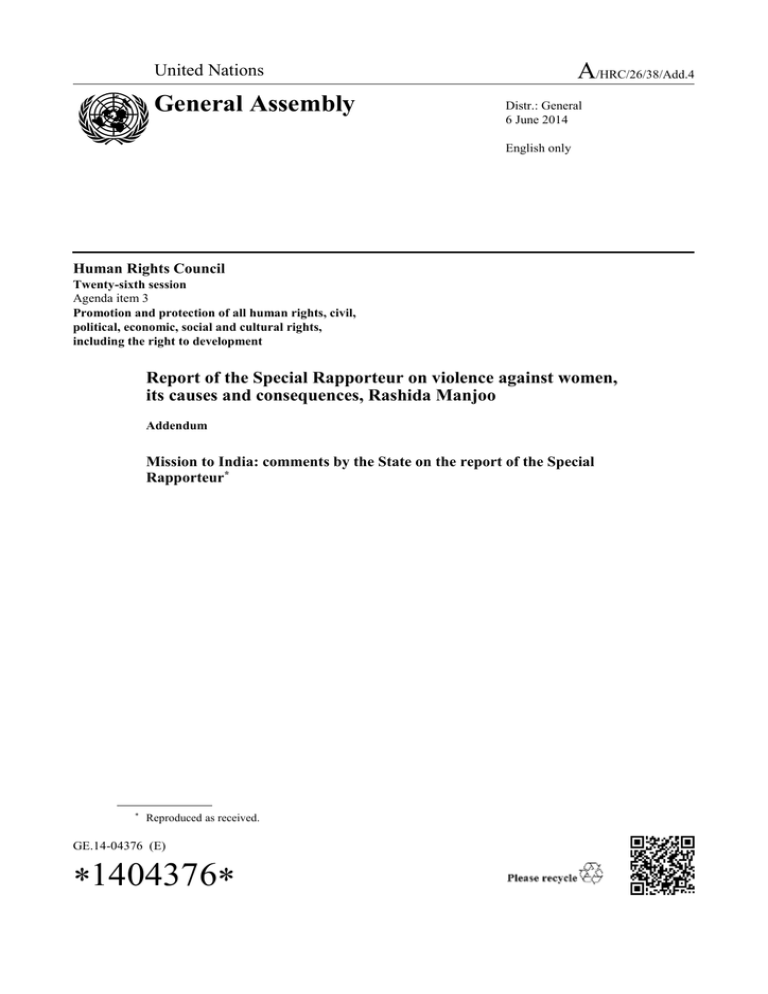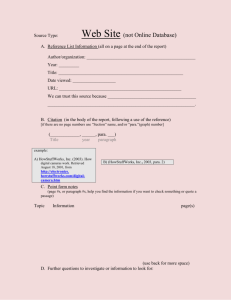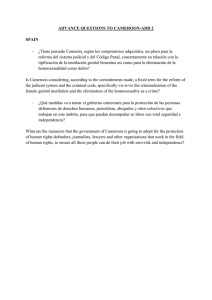
A/HRC/26/38/Add.4
United Nations
General Assembly
Distr.: General
6 June 2014
English only
Human Rights Council
Twenty-sixth session
Agenda item 3
Promotion and protection of all human rights, civil,
political, economic, social and cultural rights,
including the right to development
Report of the Special Rapporteur on violence against women,
its causes and consequences, Rashida Manjoo
Addendum
Mission to India: comments by the State on the report of the Special
Rapporteur*
*
Reproduced as received.
GE.14-04376 (E)
A/HRC/26/38/Add.4
1.
India respects the views expressed by the Special Rapporteur on Violence Against
Women, its Causes and Consequences in her Report based on her understanding developed
during the visit. India also acknowledges the independence that a Special Rapporteur ought
to exercise while presenting the conclusions, and finding thereof, in the country Report.
2.
India is constrained to make certain observations on the Report of the Special
Rapporteur as there are too many instances in the Report that leads a conclusion that the
Report lacks full objectivity and exhibits a tendency to over-simplify the issues at hand. It
is rather difficult to comprehend the reasons for the Special Rapporteur, who despite her
learned experience, has taken rather a simplistic approach while drawing conclusions, and
thereafter present them as her findings. The proclivity for making unsubstantiated yet
sweeping generalizations is very high in the Report, which tends to point to either a lack of
understanding of issues or a high degree of prejudice playing a predominant role while
arriving at such conclusions.
3.
We do not agree with the labeling of “violence against women in India as
systematic”, as noted in Paragraph 8. Such a sweeping remark smacks of a highly
prejudiced state of mind. It also fails to recognize that India, the world’s largest democracy,
values and respects the rule of law as one of its major strengths.
4.
We also do not agree with the remark in Paragraph 9 that “physical, sexual and
psychological abuse of women in the private sphere is widely tolerated by the State and the
community”.Such a general remark once againis baseless. In fact, the report itself in
paragraph 50, recognizes the “outrage and condemnation that followed the 16 th December
2012 incident where there was widespread social mobilization of citizens demanding
justice, accountability and more protection for women and girls”. Further, the report also
mentions various measures taken by the State in addressing these challenges.
5.
On the issue of ‘honour crimes’ mentioned in Para 11 of the report, it may be noted
that the Nineteenth Law Commission of India in its Report No. 242 had proposed
‘Prevention of Interference with Freedom of Matrimonial Alliance (in the name of Honour
and Tradition): A Suggested Legal Framework’ in August 2012. The report of the Law
Commission is recommendatory in nature, and such recommendations are given due
consideration by the Government.
6.
In paragraph 14, the report refers to “executions, commonly referred to as witchhunting” and alleges that there is “little or no official investigations into such violations”.
By placing this paragraph after the remarks in paragraph 13 that says “sexual violence,
including rape and sexual harassment, are widespread across the country”, the report makes
it appear as if this is a national phenomenon.Taking such isolated local incidents and
generalizing themforthe entire country brings into question the understanding of the Special
Rapporteur has of the issue as well as of the country. Official investigations are always
conducted when complaints are registered or an incident comes to light. It would have
been a fair demand if the Special Rapporteur had brought to the attention of the
Government during her visit of specific instances that came to her notice where there was
no action taken despite a complaint been lodged. Such information would have facilitated
the Government to investigate into such cases and also revert to the Special Rapporteur.
7.
The reference in Para 54 of the report that, “the National Mission for Empowerment
of Women (NMEW), an entity located in the Prime Minister’s Office’ is factually
inaccurate. The Gazette notification dated 18 March 2010 states that, ‘the NMEW shall
have National Mission Authority (NMA) at the apex level under the Chairmanship of
Hon’ble Prime Minister’.
8.
With regard to the concerns raised in the report about LGBT rights and same sex
relationships, it is to be noted that Indian law does not permit these rights under Section 377
of the Indian Penal Code. In a recent decision (Suresh Kumar Koushal v. Naz Foundation
2
A/HRC/26/38/Add.4
(India) Trust, 2013), the Supreme Court while setting aside Delhi High Court’s
decisionruled that the Parliament has to legislate on the issue and upheld Section 377 of the
Indian Penal Code, as it still remains in the statues of the country.
9.
Paragraph 57 erroneously mentions that India has seven National Human Rights
Institutions. India has only one National Human Rights Institution which is the National
Human Rights Commission (NHRC). Therearetwenty three (23)State Human Rights
Commissionsdealing with human rights in respective States in the country.
10.
The allegation that religious minorities are excluded from accessing education,
employment and adequate housing on equal terms with other citizens is totally baseless. In
fact, there are special affirmative actions for such minorities who are given special attention
by the Ministry of Minority Affairs as well as the Commission on Minorities. The Ministry
of Minority Affairs also have undertaken various schemes and measures to improve the
empowerment of women including the “leadership development of minority women with
the objective to empower and instill confidence among minority women including their
neighbours from other communities living in the same village/local by providing
knowledge, tools and techniques for interacting with banks and other institutions at all
levels.
11.
With regard to the ‘two-finger test’ referred to in Para 64, it may be noted that the
Director General of Health Services (DGHS) in 2011 discontinued the practice of ‘twofinger’ test. Further, the Supreme Court in 2013 referred that the two-finger test on a rape
victim violates her right to privacy.
12.
The Report is replete of sweeping statements and generalized allegations not
substantiated by facts. In the absence of details of allegations, the Government is not in a
position to verify them and, therefore,requests the Special Rapporteur to provide details,
failing which she should refrain from making such statements or generalized allegations.
The following are some examples:
i.
the State is policing pregnancies (Para 12).
ii.
Sexual violence, including rape and sexual harassment are widespread across
the country (Para 13).
iii.
There is high incidence of acid attack (Para 16).
iv.
There is a consistent failure in implementation of laws, and that the practices
continue. This is not acceptable in a country where rule of law is valued and
respected and there is a vigilant judiciary and citizenry (Para 17).
v.
The Special Rapporteur was informed of a troubling practice whereby a
payment incentive was offered (either in a States schemes or dowry in a family) in
exchange for marriage to women with disabilities. She was also informed of
violence perpetrated in State-sponsored shelters against women with disabilities
(Para 20).
vi.
Women living in military regions such as the Jammu & Kashmir and the
North Eastern States lives in a constant state of siege and surveillance. (Para 24).
vii.
Information received through both oral and written testimonies highlighted
the use of mass rapes allegedly by members of the States Security Forces as well as
acts of enforced disappearances, killings and acts of torture and ill-treatment which
are used to intimidate and counter-act political opposition and insurgency (Para 24).
viii. The States effort to foster economic growth and to implement development
projects are allegedly often conducted without adequate consultations with affected
3
A/HRC/26/38/Add.4
communities: with the sole objective being of one of economic growth at any cost.
(Para 26).
ix.
Trafficking of women and girls to and from India was reported as
widespread. (Para 29)
x.
Despite these positive developments, effective implementation of these laws
and the allocation of financial resources to adequately support their execution is
reportedly lacking in many instances. (Para 32)
xi.
Numerous allegations were made of de facto caste based discrimination
perpetrated by police officers, public representatives and community members, with
regard to access to services. (Para 60)
xii.
Concerns were highlighted that the criminal justice system does not fully
operate on the basis of the rule of law in accordance with international standards.
(Para 61)
xiii.
Impunity for crimes related to communal violence is the norm. (Para 67)
xvi. SR’s conclusion that the lack of effective redress provided to victim is a
“factor that contributes to a culture of normalization of violence against women”.
(Para 70)
4


